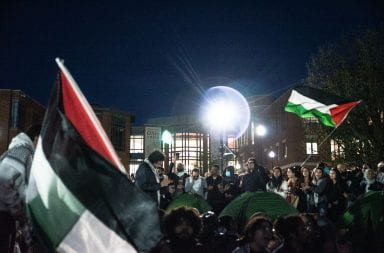Ohio State students and teachers often bear classrooms that are far too hot or cold — and for far too long.
“I literally carried a coat to one of my classes in the fall,” said Matt Bortnick, a fourth-year in international studies. “After the inexplicably freezing class ended, I took the coat off to go back outside.”
Requests to fix temperature problems must go through numerous departments at OSU.
The Facility Management and Logistics Department is one player, as its Student Life division is responsible for more than 7 million square feet of university space. The Facility Management and Logistics Department has its own Building Automation Department, which “monitors and controls heating, cooling, ventilation and related equipment” for “networked, computerized digital building control devices,” according to the department’s Web site.
But the Facility Management and Logistics Department is responsible for more than just classrooms.
“We [also] do dorms and dining halls,” said Michael Hammer, assistant director for Facilities Management. “Facilities Operations and Development [also] handles academic classrooms.”
Facilities Operations Development is a separate division from its similar-sounding facilities management counterpart.
“Other departments control temperature for dorms, hospitals, athletics and the Union,” said Mike Dixon, senior director of FOD.
Although classroom comfort can be traced to FOD, getting problems fixed is complex.
In 2008, FOD combined the separate entities of maintenance, building services and roads and grounds into one service group referred to as Regional Integrated Operations. This maneuver divided campus into three service districts, each of which is subdivided into four zones.
All classroom buildings fall into one of these four zones. All buildings have a building coordinator, and each zone has a zone leader.
If a classroom is too hot or cold, the teacher reports the problem to that building’s coordinator, who relays the information to the zone leader. The zone leader then tells the district leader, who calls Service2Facilities.
Service2Facilities, which is a joint operation between FOD and the Facility Management and Logistics Department, files a request to create a work order that university employees in the appropriate zone must respond to.
Delayed responses have been known to cause frustration.
“We have been from the North Pole to hell and back,” said Kathleen Houchens, a Spanish professor, about the temperature problems she has faced.
Every day in January, Houchens’ classroom was 88 degrees.
“I had to bring three fans to the room everyday,” she said.
University employees told Houchens that a missing part was responsible for the month of sweltering heat and advised her to wear shorts and a tank-top to class despite freezing January temperatures outside, she said.
A month after informing her building coordinator of the problem, Houchens’ room got the part it needed.
On March 30, the following message was e-mailed to OSU teachers: “Facilities Operations and Development maintenance personnel will conduct the annual heating-to-cooling season transition in several campus buildings in the weeks to come … We are working to ensure a seamless changeover from heating to cooling, but weather variations may cause unanticipated fluctuations to interior temperatures as we progress through this transition. We apologize in advance for any inconvenience.”
Under the FOD umbrella is Utilities and Energy Services and Sustainability, which works to achieve ideal temperature control.
“If a room is not being used, it is not heated or cooled until an hour or two before students show up,” said Aparna Dial, director of Energy Services and Sustainability. This is done using the FOD Building Automation Programming.
Such “setback scheduling” sets unoccupied room temperatures back from their standard set points for comfort, as outlined by the Office of Business and Finance Interim Green Build and Energy Policy.
According to the policy, “Office and academic space should maintain temperatures during the heating and air conditioning seasons at 70 and 76 degrees respectively when occupied.”
Kelly Bloomfield, building automation manager, said work orders are frequent and varied.
“We field hundreds of work orders on a daily basis,” she said. “There’s no pattern and no consistency to the problems.”
Because each building is different, there is no uniform way to address temperature concerns.
“Some buildings have direct computerized controls,” Bloomfield said. “Others have controls in each classroom, while in some older buildings, it’s just a matter of turning a valve.”
There is no denying that problems exist in maintaining comfortable temperatures in OSU classrooms, but some blame physical failures rather than a faulty organizational system.
“We have some very old equipment,” Dixon said. “Age-related issues mean pumps fail and valves fail.”


